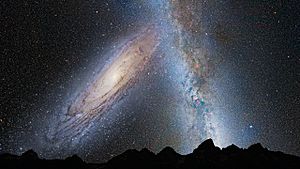Milky Way–Andromeda collision facts for kids

Get ready for a cosmic event! Our home galaxy, the Milky Way, is on a collision course with its closest large neighbor, the Andromeda galaxy. This amazing event is expected to happen in about four billion years.
The Andromeda galaxy is currently moving towards the Milky Way at a speed of about 110 kilometers per second. Scientists know this because of something called blueshift, which means light from Andromeda is shifting towards the blue end of the spectrum as it gets closer to us. For a long time, experts weren't sure if a direct collision would actually happen, because it was hard to measure Andromeda's sideways movement.
Contents
Confirming the Galactic Crash
In 2012, scientists finally confirmed that the collision is definitely going to happen. They used the powerful Hubble Space Telescope to carefully watch the movement of stars in Andromeda. They tracked these stars between 2002 and 2010.
How Hubble Helped
The Hubble Space Telescope helped astronomers measure Andromeda's sideways speed. They found that this sideways speed was much, much smaller than the speed at which Andromeda is moving directly towards us. This discovery meant that a direct crash is very likely. So, in about 4 billion years, our two giant galaxies will meet!
Galaxy Collisions: A Common Event
You might think a galaxy collision is a rare and scary event, but it's actually quite common in the universe! Galaxies often pull on each other and sometimes even merge.
Past Collisions of Andromeda
Andromeda itself has crashed into at least one other galaxy in the past. This shows that galaxies are always interacting and changing.
Milky Way's Current Mergers
Even our own Milky Way galaxy is already "eating" smaller galaxies! Several dwarf galaxies, like the Sagittarius Dwarf Elliptical Galaxy, are currently colliding with the Milky Way and being absorbed into it.
Famous Galactic Collisions
A great example of two spiral galaxies crashing is the Antennae galaxies. These two galaxies are roughly the same size and are actively merging, creating lots of new stars in the process. Studying these types of collisions helps scientists understand what might happen when the Milky Way and Andromeda meet.
See also


